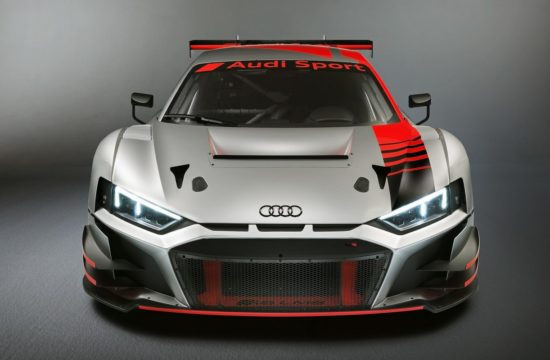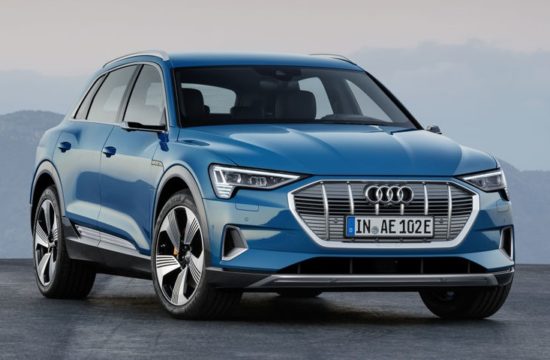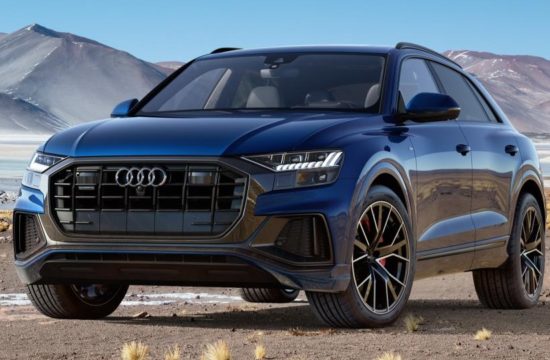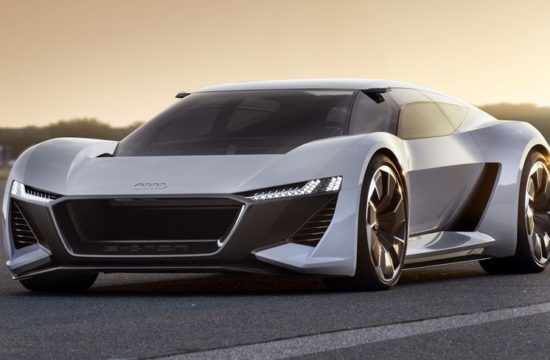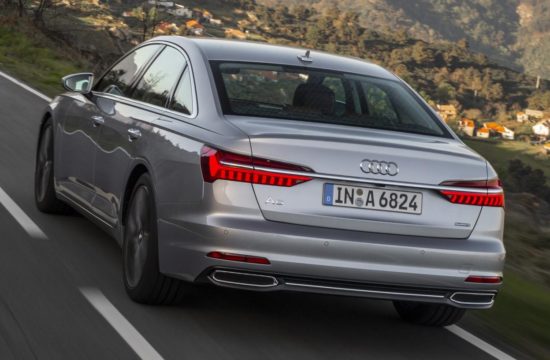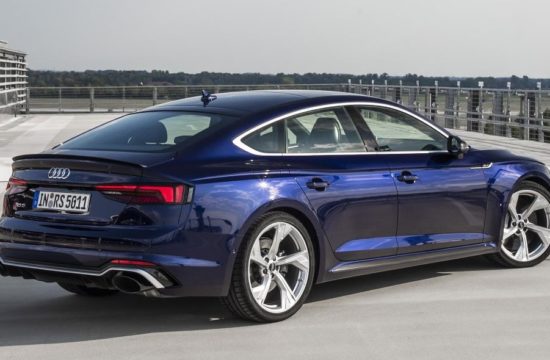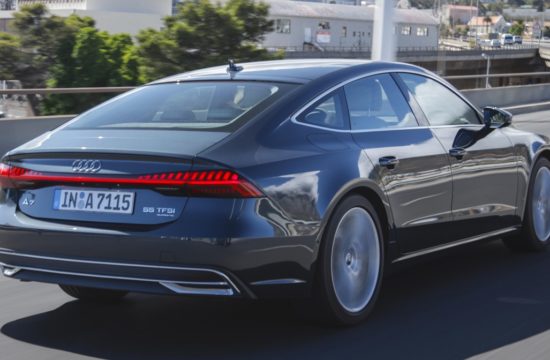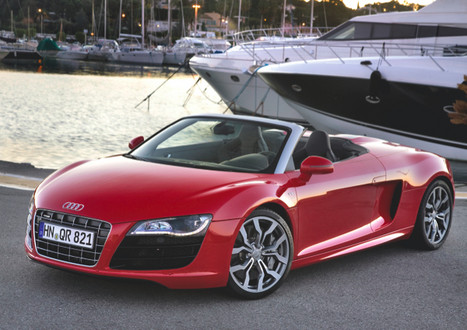
Audi R8 Coupe was first launched with a V8 engine, with the V10 variant added to the range later, and that’s kinda how it works. But for the R8 Spyder, Audi has gone the other way around and as the V10 version of the car is currently on the market, they are introducing a weaker but more affordable V8 model.
So the R8 Spyder 4.2 FSI quattro gets the same 430 hp and 317.15 lb-ft of torque engine as the V8 Coupe, which enables to go from 0 to 60 mph in 4.8 seconds and keep going to a top speed of 185 mph (299 km/h). You can have it with a manual transmission or the R tronic dual-clutch, but with either of those it’s not what you call economical!
The R8 Spyder 4.2 FSI quattro with the R tronic consumes on average 13.9 liters of fuel per 100 km (16.92 US mpg); fuel consumption with the manual transmission is 14.9 liters per 100 km (15.79 US mpg), even though brake energy recuperation system has been fitted as standard.
Other features of the car are the same as the current Spyder, same design, same cloth roof and same equipments. But pricing for this one starts from 121,000 Euros.
Audi R8 Spyder V8 engine in details:
The free-breathing 4.2 FSI is a high-performance engine such as can be found in racing. It delivers an experience that enthralls all of the senses – with spontaneous, voracious throttle response, with its easy revving, with hefty torque, prodigious power and sonorous, voluminous music.The V8 accelerates the R8 Spyder from zero to 100 km/h (62.14 mph) in 4.8 seconds and on up to a top speed of 299 km/h (185.79 mph). Both values apply for the manual transmission and for the R tronic. At Audi, dynamics also always means efficiency. The R8 Spyder 4.2 FSI quattro with the R tronic consumes on average 13.9 liters of fuel per 100 km (16.92 US mpg); fuel consumption with the manual transmission is 14.9 liters per 100 km (15.79 US mpg). A recuperation system that recovers energy during braking is standard. The forced oil pump of the dry sump lubrication system features various suction and discharge stages for load-dependent operation.
The 4.2 FSI, which is also used in this form in the R8 Coup?, produces 316 kW (430 hp) from a displacement of 4,163 cc – 73.5 kW (103.2 hp) per liter. At the nominal engine speed of 7,900 rpm, the long-stroke (bore x stroke 84.5 x 92.8 millimeters [3.33 x 3.65 in]) engine’s eight pistons travel 24.1 meters (79 ft) each second. The electronic rev limiter kicks in at 8,250 rpm. The V8 delivers 430 Nm (317.15 lb-ft) of torque to the crankshaft between 4,500 and 6,000 rpm, with at least 90 percent of peak torque available between 3,500 and 7,500 rpm.
The compact V8, which is hand-assembled at the engine factory in Gy?r, Hungary, has the classic cylinder angle of 90 degrees and weighs just 216 kilograms (476 lb). Its crankcase is made of an aluminum-silicon alloy using the low-pressure die casting method, which ensures particular homogeneity. The high silicon content makes the cylinder barrels extremely resistant to wear.
A bedplate structure gives the crankcase its high rigidity and optimal vibration behavior. The cast iron bearing bridges reduce its thermal expansion and thus keep the play at the main bearings of the crankshaft within tight limits. The forged crankshaft, the forged steel connecting rods and the forged aluminum pistons are extremely lightweight, yet strong. The dry sump lubrication system with its separate oil tank enables the engine to be installed very low while also ensuring the supply of oil to the engine even under extreme lateral acceleration.
The high-revving V8 FSI draws its fuel from an FSI gasoline direct injection system – typically Audi. The common rail unit injects the fuel at up to 120 bars of pressure. The fuel mixture is swirled intensely in the combustion chambers and thus cools the walls. This allows a high compression of 12.5:1, for increased performance and efficiency. The 32 valves are actuated via roller cam followers by four camshafts, each of which can be moved through 42 degrees of crankshaft rotation. They and the ancillaries are driven by zero-maintenance chains running on the back side of the engine.
The 4.2 FSI breathes through straight aluminum velocity stacks 23 centimeters (9.06 in) in length integrated into the dual intake system. The intake plenum is made of lightweight plastic. Vacuum-actuated flaps controlled by the engine management system are integrated into the intake ports. They cause the air to move with a roller-like rotation (to “tumble”), which increases the efficiency of the combustion process.
The dual-branch exhaust system features dual tailpipes. The exhaust system components and the pipes of the manifold have been designed for low backpressure and are very light. The exhaust flaps in both tailpipes open at higher load and engine speed for an even fuller sound.
Dynamic: the drivetrain
The Audi R8 Spyder 4.2 FSI quattro comes standard with a manual six-speed transmission. It works together with a compact dual-disc clutch and can be shifted extremely precisely and easily with short throws. The shift lever is made of polished aluminum, the open gate of stainless steel.The R8 Spyder 4.2 FSI quattro is optionally available with the R tronic, a highly efficient sequential six-speed transmission. Shift commands are transmitted electrically; a hydraulic system changes the gears and manages the clutch. The R tronic offers both an automatic and a manual mode, both of which allow the driver to choose between two shift programs.
In manual mode, the driver changes gears using the joystick on the center tunnel or with the paddles on the steering wheel. At high load and engine speed, gear changes take less than a tenth of a second. The Launch Control program ensures optimal starts. It controls the engine speed and the engagement of the clutch to accelerate the open-top two-seater with the ideal wheel slip.
The quattro permanent all-wheel drive delivers the engine’s power to all four wheels. Together with the locking differential on the rear axle, it provides significantly greater traction, stability, cornering speed and precision. The four powered wheels seem to claw into the asphalt at the exit of the corner, and the driver can get back on the throttle sooner than in a car with rear-wheel drive.
Due to the mid-engine layout, the quattro all-wheel drive system in the R8 Spyder is a special design with a strong rear bias. The transmission, which is mounted behind the longitudinally installed V8, has an auxiliary drive for a cardan shaft running past the engine to the front.
A viscous coupling distributes the torque at the front axle. During normal driving, it sends roughly 15 percent of the torque to the front wheels and 85 percent to the rear wheels. If the rear wheels begin to slip, an additional 15 percent is quickly sent to the front. A locking differential at the rear axle further improves dynamics. It provides up to 25 percent lockup when accelerating and up to 45 percent when coasting. If a wheel on one of the axles should slip, it is braked by the EDS electronic locking differential.


